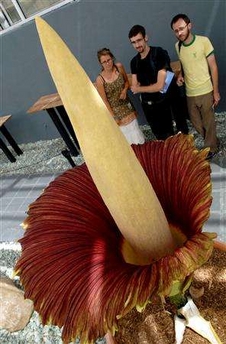The Corpse Flower . . .
Foul-smelling bloom a hit
(Reuters)
Updated: 2006-08-14 19:47
NEW YORK - An arum by any other name would smell as rank -- so it's just called the corpse flower.
Crowds flocked to the Brooklyn Botanic Garden on Friday to see what the big stink was about -- the rare blooming of a cultivated amorphophallus titanum, one of the world's largest flowers. It also is perhaps the world's most foul-smelling plant and puts out an aroma not unlike rotting meat or fish.
"I had to wear a respirator," said Alessandro Chiari, a plant propagator who, along with garden foreman Mark Fisher, raised the flower from a pea-sized tuber to maturity at more than 5 feet.
"It comes in waves," Chiari said of the plant's foul smell, which serves the purpose of attracting hungry bees and insects that pollinate its female flowers. The plant, also called a titan arum, does not pollinate itself.
One of the air-monitoring technicians said the smell made her eyes water and the greenhouse's windows were opened for ventilation.
As fate would have it, the aroma peaked during the wee hours when the garden was closed and some who turned out to get a whiff seemed almost disappointed to have missed its peak.
"It's actually a very organic kind of smell," said Adam Husted of Brooklyn. "I don't know if it's really putrid though."
As crowds snapped photos and sniffed the plant, one visitor said she was "kind of relieved."
"I was a little afraid of something really nauseating," she said.
The last time a titan arum, native to Sumatra, bloomed in New York was in 1939, garden officials said. Only a handful have flowered in the United States in the past few decades.
"It's such a beautiful thing," Fisher said of what he calls his "baby," which was raised over 10 years from a tiny, 2-month-old tuber that came from a North Carolina nursery.
Resembling a freakishly appealing love child of a crenelated cabbage and a calla lily, the plant produces a bud each year before going dormant. Fisher said that a leaf reached 18 feet tall last summer.
But this year was its first flowering, noteworthy for the giant, phallic spadex that springs from the leaf, which grew as much as five inches a day.
Like many of nature's most spectacular feats, the corpse flower's blooming will be short-lived and the plant is expected to collapse in another day or two. But the garden's experts have obtained pollen and will manually pollinate "baby." If successful, that will produce seeds that will be distributed to other gardens.
First discovered in 1878 in western Sumatra, the plant, whose name means "deformed phallus," was introduced into cultivation at the Royal Botanic Garden, Kew, in London in 1889. Because of its appearance, Victorian woman were kept from viewing it.

